Making the Rounds
I want to begin today's article by extending another sincere thank you to everybody who has sent me deck submissions so far. There are more of you than I initially expected, and even in my own fantasy I didn't anticipate how many would be willing to put their decks under the knife. I will unfortunately not be able to cover everyone in this column (unless I quit my day job and make this a daily thing, and even then it'd be a stretch at the rate I'm getting submissions), but I hereby vow to respond to everyone. If you sent me something and haven't heard back yet, it's simply because I've not yet had the time to formulate a proper response. Know that I will get in touch with you in some form, but it might be a while yet. And keep the submissions coming, you guys are awesome!
All of this aside, let's meet today's patient! This time, I'm taking a look at a very interesting Ramos, Dragon EngineRamos, Dragon Engine deck sent in to me by Lavie.
United Colors Engine
View on ArchidektCommander (1)
- 1 Ramos, Dragon EngineRamos, Dragon Engine
Creatures (28)
- 1 Acidic SlimeAcidic Slime
- 1 Anafenza, the ForemostAnafenza, the Foremost
- 1 Aviary MechanicAviary Mechanic
- 1 Birds of ParadiseBirds of Paradise
- 1 Coiling OracleCoiling Oracle
- 1 Deathrite ShamanDeathrite Shaman
- 1 Deputy of AcquittalsDeputy of Acquittals
- 1 Drift of PhantasmsDrift of Phantasms
- 1 Elesh Norn, Grand CenobiteElesh Norn, Grand Cenobite
- 1 Elvish VisionaryElvish Visionary
- 1 Emancipation AngelEmancipation Angel
- 1 Eternal WitnessEternal Witness
- 1 Farhaven ElfFarhaven Elf
- 1 Fleetfoot PantherFleetfoot Panther
- 1 Forgotten AncientForgotten Ancient
- 1 Ghave, Guru of SporesGhave, Guru of Spores
- 1 Jeskai BarricadeJeskai Barricade
- 1 Marchesa, the Black RoseMarchesa, the Black Rose
- 1 Mystic SnakeMystic Snake
- 1 Purphoros, God of the ForgePurphoros, God of the Forge
- 1 QuicklingQuickling
- 1 Rune-Tail, Kitsune AscendantRune-Tail, Kitsune Ascendant
- 1 Soul of the HarvestSoul of the Harvest
- 1 StonecloakerStonecloaker
- 1 Voidmage HusherVoidmage Husher
- 1 Whitemane LionWhitemane Lion
- 1 Wood ElvesWood Elves
- 1 Yavimaya DryadYavimaya Dryad
Instants (10)
- 1 Anguished UnmakingAnguished Unmaking
- 1 Eladamri's CallEladamri's Call
- 1 Enlightened TutorEnlightened Tutor
- 1 Go for the ThroatGo for the Throat
- 1 ManamorphoseManamorphose
- 1 MortifyMortify
- 1 PutrefyPutrefy
- 1 Rend FleshRend Flesh
- 1 Swords to PlowsharesSwords to Plowshares
- 1 Utter EndUtter End
Sorceries (9)
- 1 Bring to LightBring to Light
- 1 CultivateCultivate
- 1 Declaration in StoneDeclaration in Stone
- 1 FarseekFarseek
- 1 Green Sun's ZenithGreen Sun's Zenith
- 1 Kodama's ReachKodama's Reach
- 1 OustOust
- 1 Rampant GrowthRampant Growth
- 1 Search for TomorrowSearch for Tomorrow
Enchantments (12)
- 1 AlurenAluren
- 1 Aura ShardsAura Shards
- 1 Awakening ZoneAwakening Zone
- 1 Cathars' CrusadeCathars' Crusade
- 1 Doubling SeasonDoubling Season
- 1 EquilibriumEquilibrium
- 1 Fable of Wolf and OwlFable of Wolf and Owl
- 1 Ineffable BlessingIneffable Blessing
- 1 Mirari's WakeMirari's Wake
- 1 Primal VigorPrimal Vigor
- 1 Privileged PositionPrivileged Position
- 1 Rhystic StudyRhystic Study
Artifacts (4)
- 1 Chromatic LanternChromatic Lantern
- 1 Cloudstone CurioCloudstone Curio
- 1 Lightning GreavesLightning Greaves
- 1 Sol RingSol Ring
Lands (36)
- 1 Arcane SanctumArcane Sanctum
- 1 Bloodstained MireBloodstained Mire
- 1 Breeding PoolBreeding Pool
- 1 BrushlandBrushland
- 1 City of BrassCity of Brass
- 1 Command TowerCommand Tower
- 1 Crumbling NecropolisCrumbling Necropolis
- 1 Exotic OrchardExotic Orchard
- 1 Flooded StrandFlooded Strand
- 3 ForestForest
- 1 Frontier BivouacFrontier Bivouac
- 2 IslandIsland
- 1 Jungle ShrineJungle Shrine
- 1 Mana ConfluenceMana Confluence
- 2 MountainMountain
- 1 Mystic MonasteryMystic Monastery
- 1 Nomad OutpostNomad Outpost
- 1 Opal PalaceOpal Palace
- 1 Overgrown TombOvergrown Tomb
- 1 Path of AncestryPath of Ancestry
- 2 PlainsPlains
- 1 Polluted DeltaPolluted Delta
- 1 Reflecting PoolReflecting Pool
- 1 Savage LandsSavage Lands
- 1 Seaside CitadelSeaside Citadel
- 1 SwampSwamp
- 1 Temple GardenTemple Garden
- 1 Watery GraveWatery Grave
- 1 Windswept HeathWindswept Heath
- 1 Wooded BastionWooded Bastion
- 1 Yavimaya CoastYavimaya Coast
Link to the deck on Deckstats: Click.
This is a rather different take on Ramos, Dragon EngineRamos, Dragon Engine. It utilizes the commander as part of a big value engine, casting, bouncing and re-casting creatures to both grow Ramos and abuse enters-the-battlefield effects. We are thus dealing with a mixture of strategies that I like to think blends well together with the commander.
There are a few things I don't really like with the deck list as it stands. My issues are mostly connected to the supporting parts of the deck. The engine itself, both of the dragon kind and the deck kind, tended to work quite well in my playtest games, though I will comment on that too. This article will focus on the deck's suites for removal and card advantage. The deck has some great pieces of removal and some removal that we could do without or make a bit better, and we're missing at least one or two board sweepers in case we fall behind. The draw engine is much too small, in my book, and even though we do tend to get to a point where most spells we play generate virtual card advantage, since we bounce our own things and re-play them for value, we have to find the cards to get us there, and I had some issues with that in my games.
I will also discuss cutting cards in general, and broadly my own method of doing so.
The EDHREC Engine take on a Dragon Engine
When inputting this deck into EDHREC.com's "Recs" function, a few things become evident. First of all, the site suggests quite a few pieces of mass removal or board sweepers, and secondly, the site suggests a lot of lands. I won't go into details when it comes to the manabase in this article; I think it looks just fine as-is. Way back in the day, there was a set called Apocalypse and one of the preconstructed theme decks released with the set was a quite typical "five-color green" deck called "Pandemonium". It's a five-color deck, but it's largely green and uses green's ability to fix and ramp to get to the other colors. I think that this is a useful perspective when building EDH decks today, if you don't own the small fortune in cardboard to go the "ten fetches, ten shocks, ten duals" route. Lavie has indeed made use of some shocks and fetches, but much of the deck is green and almost all of the early game ramp is green. This is just fine.
Lands aside thus, we're left with suggestions such as Cyclonic RiftCyclonic Rift, Merciless EvictionMerciless Eviction, Commander's SphereCommander's Sphere, ConfluxConflux, and Darksteel IngotDarksteel Ingot as well as a few other interesting choices which I will cover later on. The deck's goal seems to stray a bit far from the commander's norm aside this, though a suggestion that pops up which fits the theme quite nicely is Corpesjack MenaceCorpesjack Menace.
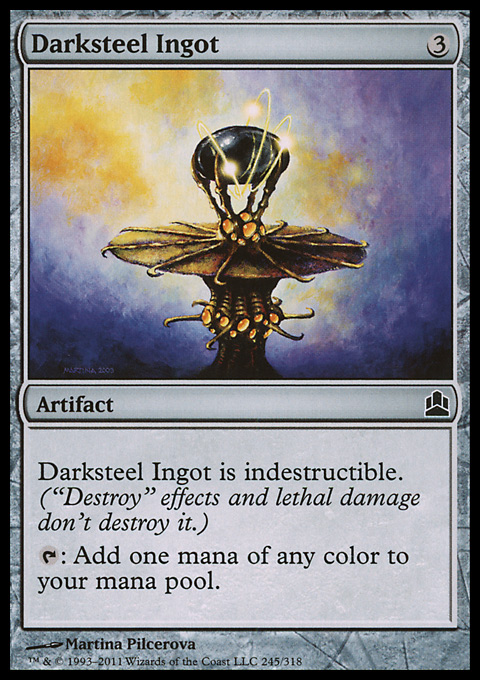
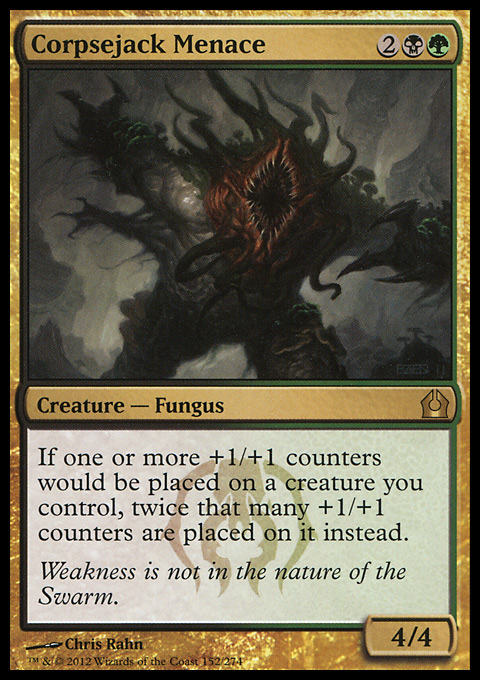
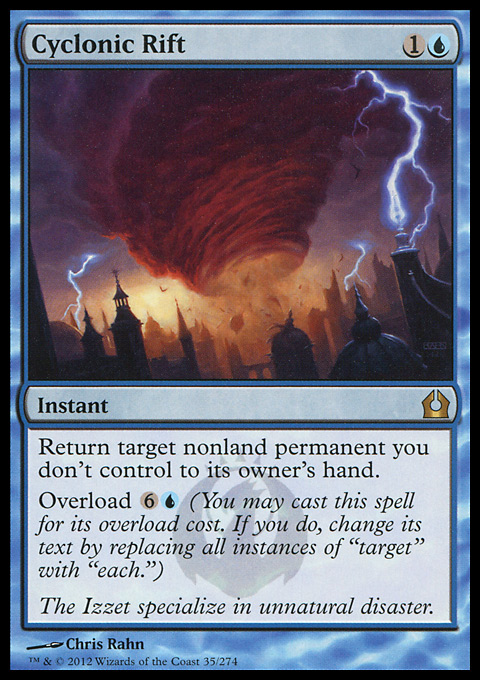
The Doctor's Take
This is quite probably one of the most technical decks I've been sent so far. It almost makes me want to jest that it's the Magic equivalent of a Rube Goldberg-machine, but that wouldn't been fair. A Rube Goldberg-machine, after all, makes a point out of needless complexity, and that's not what we're dealing with. Rather, we're looking at a highly synergistic, quite well-tuned machine, which sometimes needs a bit of time to get going. I intend to tune it up, change the oil, and make it shine!
The first thing that I want to focus on is card draw. The deck really only employs four pieces of card draw: Rhystic StudyRhystic Study, Coiling OracleCoiling Oracle, Soul of the HarvestSoul of the Harvest, and Elvish VisionaryElvish Visionary. The two former are both fantastic, both format staples for a reason. That said, these are all conditional - Rhystic StudyRhystic Study is dependent on our opponents casting spells, and the others either rely on creatures entering the battlefield or are themselves essentially cantrips. These need to be a part of the machine to function, meaning that if we are disrupted too much, we can get stuck with few cards in hand and not many ways to get going again.
On the removal side, there are a few options which I find less-than desireable. OustOust is cheap, deals quite effectively with indestructable creatures, but is a sorcery and is rendered useless by most any type of card draw. Declaration in StoneDeclaration in Stone is pretty fantastic against tokens and exiles, so again good against indestructable threats and graveyard decks, but is also a sorcery and we're giving our opponents free stuff for their removed creatures. Rend FleshRend Flesh is an interesting choice, but I think we can do better seeing as how we're in all five colors.
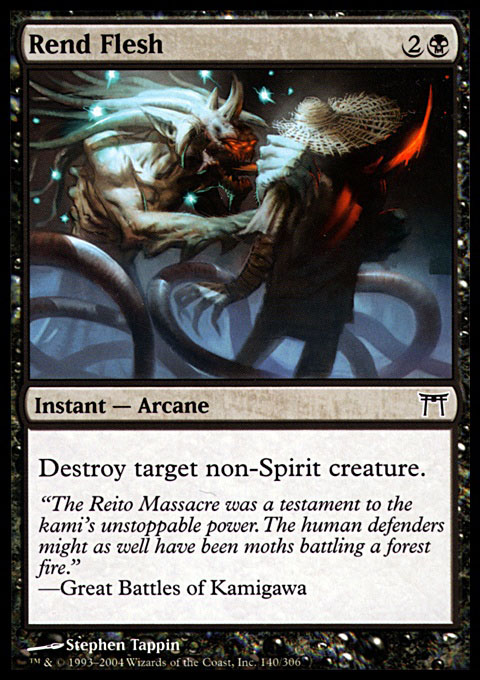
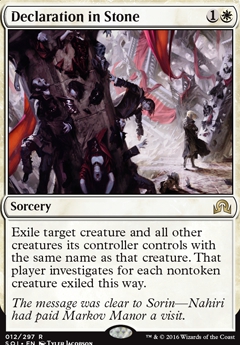
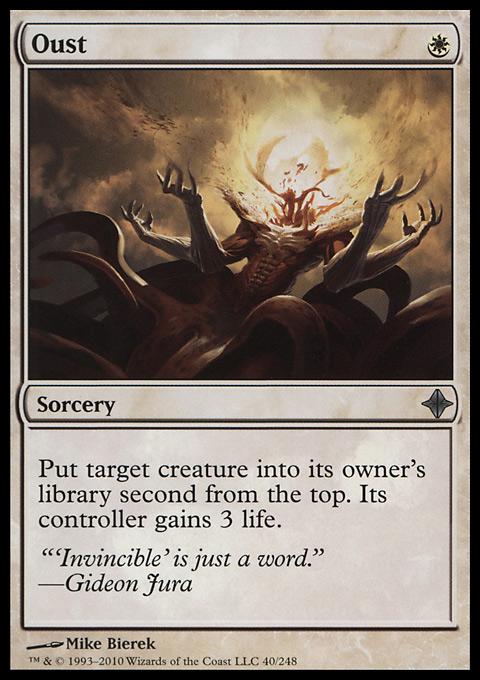
Cutting into the Patient!
One of the hardest things to do when building a new deck or making changes to an old one is deciding what to not include or what to take out. Cutting cards is something that can be satisfying as well, and I like to think that part of the satisfaction comes from difficulty. A single exclusion can linger in my mind for days at a time if one of my decks is well-tuned, and most of them seems to be in a perpetual brewing state, meaning cards tend to go in and out before most every play session, not just with new set releases.
Starting with making basic cuts, however, I like to do a rough breakdown of my deck, and then use a tiered system. Almost all of my decks start with the following:
- 37-38 mana-producing lands. This can go either up or down depending on what the curve ends up looking like, how many colors are in the deck, and so on.
- Around 10 sources of ramp. This includes everything from Sol RingSol Ring to FarseekFarseek to Wood ElvesWood Elves in this deck, for example. I like to keep most of the ramp cards cheap, and only occasionally include cards like Thran DynamoThran Dynamo. You'll want to spend the early turns ramping, and unless you have some big bombs in the deck to cast for lots of mana, I tend to leave any ramp cards with a higher converted mana cost than three aside. The obvious exception to this rule is Solemn SimulacrumSolemn Simulacrum.
- Around 10 sources of card draw.
This means that, including the commander, we're at about 60 or so cards already. This leaves roughly forty slots. I use a "box" system and store all my EDH playables in color-sorted boxes, so when brewing I look through all of my cards in the proper colors and I put aside any I could see myself playing in the deck. Then, I take this stack of card, do a rough run-through and toss any obvious exclusions, and finally break it all down in a three-tiered system:
- Tier 1: Here, I put all the cards that are dealing with the deck's central theme, and cards that will actively advance my own game plan. I will discuss theme in a later article as well, but for now, we can focus on this patient's theme: +1/+1 counters on our commander, bouncing and re-using creatures, and generating value from that..
- Tier 2: Here I put cards that are good in the deck but don't really touch upon the central theme. Prime examples are any removal spells, board sweepers, counterspells, utility value cards like Lightning GreavesLightning Greaves and so on.
- Tier 3: Here I put card that are cool and that I would like to include, but aren't central to the deck's theme, or aren't very useful in general, as per tier 1 and tier 2 rules.
With these piles done, I tend to add most of the tier 1 cards, flip through the tier 2 pile and add some of the best cards, and then season to taste with a cool card or two from the tier 3 pile.
This quite methodological approach to deckbuilding leads to two pretty big upsides: I often tend to end up with a pretty focused and playable first draft, and I also tend to quickly weed out the unplayable stuff. Most times it won't be anywhere near a "finished EDH deck" (though that's an oxymoron in my book), but I will end up with something that I could sleeve up and take to my local club for a test spin.
In the example of Lavie's Ramos, Dragon EngineRamos, Dragon Engine brew, we're beyond this point, and we're dealing with much more fine-tuned cuts - we're looking at optimizing an already working build, and I will try to do just that. I am telling you this, however, because this is also essentially how I work when it comes to weeding out the suggestions for your decks, and also to provide you all with a possible tool for your future deck building endeavors.
The Ins and the Outs
As I've stated before in this article, my two main focal points for my cuts are to a) sharpen the removal suite to be more powerful, and b) expand on the card draw engine to both make the deck chug along more smoothly, and allow it to recover from disruption. To find proper suggestions, I didn't just look at Ramos, Dragon EngineRamos, Dragon Engine's EDHREC page, I also took a look at the +1/+1 counters theme section, and I've also looked at commanders which might in some way mirror this deck's central theme - Atraxa, Praetor's VoiceAtraxa, Praetor's Voice and Roon of the Hidden RealmRoon of the Hidden Realm to name a few. This is a great way to find new suggestions if your deck doesn't follow the norm for the commander in question. In any case, the changes are as follows:
- 1 Rend FleshRend Flesh
- 1 OustOust
- 1 Declaration in StoneDeclaration in Stone
- 1 Go for the ThroatGo for the Throat
- 1 MortifyMortify
- 1 PutrifyPutrify
- 1 Ineffable BlessingIneffable Blessing
- 1 Awakening ZoneAwakening Zone
Having a few pieces of spot removal in any EDH deck is generally a good idea. They allow you to deal with both offensive and defensive threats either knocking on your doors or standing in your way respectively. However, just loading up on spot removal usually isn't the way to go - in most games of Magic it's fine to trade one-for-one, but in a four+player game you're setting yourself and one of your three opponents back one card, while the other two lose nothing. The same is most often true for countermagic. I have thus chosen to cut down on the spot removal, but kept the best and most flexible pieces - Anguished UnmakingAnguished Unmaking and Utter EndUtter End are fantastic in their flexibility, Acidic SlimeAcidic Slime and Mystic SnakeMystic Snake come with bodies on them meaning they don't generate the same card disadvantage, and they can be reused.
Ineffable BlessingIneffable Blessing (the variant that draws cards when either creatures with or without flavor texts enters the battlefield is the one in question, by the way) is a fantastically cool card, and I can see it doing a lot of work in the deck, but I've elected to cut it due to its silver border. If your playgroup is fine with Un-cards, I would probably run it in a heart beat. Awakening ZoneAwakening Zone is pretty good overall, especially with Doubling SeasonDoubling Season in play, but in my testing it was always the least good ramp card, and we're pretty set without it so it gets the axe. Drift of PhantasmsDrift of Phantasms is cute, and almost got the axe because it's within the risk of being too cute. However, it has been useful as an early blocker, and it can always be returned to be transmuted later on.
Lavie hasn't given me a set budgetary restriction, but I will refrain from adding some really expensive cards to the "Other options" section. This is what I would consider the tier 1 additions:
- 1 Abzan CharmAbzan Charm
- 1 Prime Spekaer ZeganaPrime Spekaer Zegana
- 1 Rishkar's ExpertiseRishkar's Expertise
- 1 Shapers of NatureShapers of Nature
- 1 Crystal ShardCrystal Shard
- 1 Erratic PortalErratic Portal
- 1 Hadana's ClimbHadana's Climb
- 1 Birthing PodBirthing Pod
The first four cards are all card draw spells which are either very flexible or synergise with the deck's strategy overall. Abzan CharmAbzan Charm is a personal favorite of mine own which can act as card draw at instant speed, as removal, or as a flexible pump spell. It also adds no less than three counters to Ramos, Dragon EngineRamos, Dragon Engine! Prime Speaker ZeganaPrime Speaker Zegana is extremely powerful, especially when she is bounced and re-cast for additional triggers, and Rishkar's ExpertiseRishkar's Expertise has been one of the break-out cards of Aether Revolt for a good reason. It demands a big creature in play, but we always have our commander who will at the very least be a 5/5 when Rishkar's ExpertiseRishkar's Expertise resolves, often bigger. Shapers of NatureShapers of Nature is slow but more or less unconditional card draw which has other utility uses as well, and works well with the Doubling SeasonDoubling Season et al in the deck. Crystal ShardCrystal Shard and Erratic PortalErratic Portal are both good utility effects for re-using our creatures, and can work as pseudo-removal as well. My experience is that people tend to accidentally tap out after a couple of turns, since board states in this format are complex, and it's easy to miss a lone Crystal ShardCrystal Shard. Hadana's ClimbHadana's Climb will flip immediately if we target our commander with it in the first main phase and then trigger it in our combat step, and the flipped land is a powerful voltron-like option to start hitting people with Ramos, Dragon EngineRamos, Dragon Engine for big chunks of damage. Lastly Birthing PodBirthing Pod is a disgustingly good utility card which I think belongs in the deck due to the sheer number of creatures and thus possible lines of play.
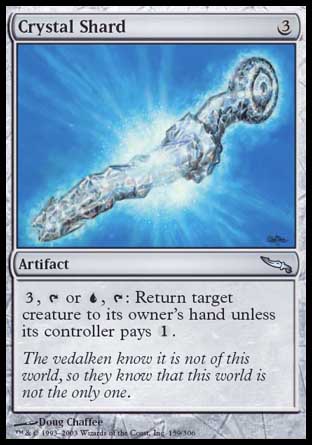
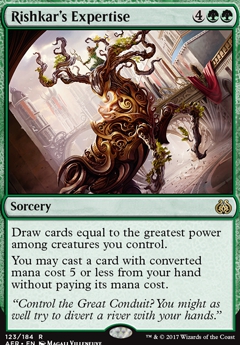
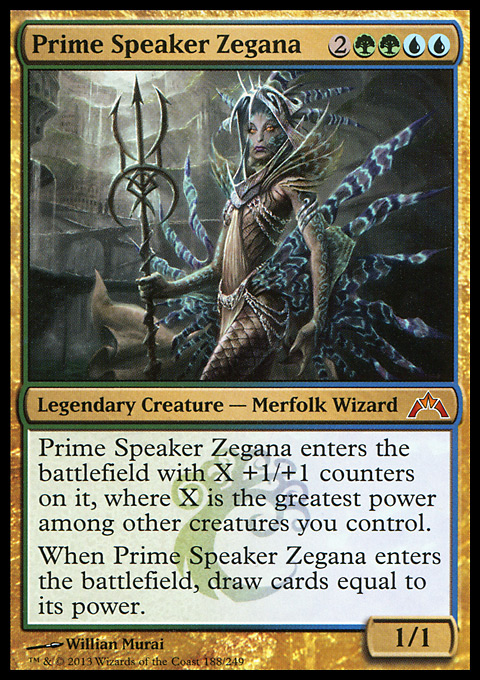
OTHER OPTIONS
View on Archidekt- 1 Survival of the FittestSurvival of the Fittest
- 1 GenesisGenesis
- 1 Hardened ScalesHardened Scales
- 1 Winding ConstrictorWinding Constrictor
- 1 Corpsejack MenaceCorpsejack Menace
- 1 Path of DiscoveryPath of Discovery
- 1 Fathom MageFathom Mage
- 1 Warstorm SurgeWarstorm Surge
- 1 Cyclonic RiftCyclonic Rift
- 1 Merciless EvictionMerciless Eviction
These are all cards that didn't fit my build, but could well compete for a place. Survival of the FittestSurvival of the Fittest is nothing short of fantastic, and is along with GenesisGenesis worthy of inclusion in any creature-based decks. It does tend to put a strain on the pilot, since the growing number of lines of play makes a deck more difficult to pilot optimally (if that's even a goal), and the added shuffling eats up time, so be careful! There are a number of cards that interact with +1/+1 counters, and I've picked my favorites to include above. Either could work in the deck, but most would benefit if the deck is re-tooled to focus more on +1/+1 counters, hence why they aren't easy INs. Warstorm SurgeWarstorm Surge is a more political Purphoros, God of the ForgePurphoros, God of the Forge, but not necessarily stronger.
The final iteration
The changes above leaves us with a deck which looks like this:
Ramos, Engine Reignited
View on ArchidektCommander (1)
- 1 Ramos, Dragon EngineRamos, Dragon Engine
Creatures (30)
- 1 Acidic SlimeAcidic Slime
- 1 Anafenza, the ForemostAnafenza, the Foremost
- 1 Aviary MechanicAviary Mechanic
- 1 Birds of ParadiseBirds of Paradise
- 1 Coiling OracleCoiling Oracle
- 1 Deathrite ShamanDeathrite Shaman
- 1 Deputy of AcquittalsDeputy of Acquittals
- 1 Drift of PhantasmsDrift of Phantasms
- 1 Elesh Norn, Grand CenobiteElesh Norn, Grand Cenobite
- 1 Elvish VisionaryElvish Visionary
- 1 Emancipation AngelEmancipation Angel
- 1 Eternal WitnessEternal Witness
- 1 Farhaven ElfFarhaven Elf
- 1 Fleetfoot PantherFleetfoot Panther
- 1 Forgotten AncientForgotten Ancient
- 1 Ghave, Guru of SporesGhave, Guru of Spores
- 1 Jeskai BarricadeJeskai Barricade
- 1 Marchesa, the Black RoseMarchesa, the Black Rose
- 1 Mystic SnakeMystic Snake
- 1 Prime Speaker ZeganaPrime Speaker Zegana
- 1 Purphoros, God of the ForgePurphoros, God of the Forge
- 1 QuicklingQuickling
- 1 Rune-Tail, Kitsune AscendantRune-Tail, Kitsune Ascendant
- 1 Shapers of NatureShapers of Nature
- 1 Soul of the HarvestSoul of the Harvest
- 1 StonecloakerStonecloaker
- 1 Voidmage HusherVoidmage Husher
- 1 Whitemane LionWhitemane Lion
- 1 Wood ElvesWood Elves
- 1 Yavimaya DryadYavimaya Dryad
Instants (7)
- 1 Abzan CharmAbzan Charm
- 1 Anguished UnmakingAnguished Unmaking
- 1 Eladamri's CallEladamri's Call
- 1 Enlightened TutorEnlightened Tutor
- 1 ManamorphoseManamorphose
- 1 Swords to PlowsharesSwords to Plowshares
- 1 Utter EndUtter End
Sorceries (8)
- 1 Bring to LightBring to Light
- 1 CultivateCultivate
- 1 FarseekFarseek
- 1 Green Sun's ZenithGreen Sun's Zenith
- 1 Kodama's ReachKodama's Reach
- 1 Rampant GrowthRampant Growth
- 1 Riskhar's ExpertiseRiskhar's Expertise
- 1 Search for TomorrowSearch for Tomorrow
Enchantments (11)
- 1 AlurenAluren
- 1 Aura ShardsAura Shards
- 1 Cathars' CrusadeCathars' Crusade
- 1 Doubling SeasonDoubling Season
- 1 EquilibriumEquilibrium
- 1 Fable of Wolf and OwlFable of Wolf and Owl
- 1 Hadana's ClimbHadana's Climb
- 1 Mirari's WakeMirari's Wake
- 1 Primal VigorPrimal Vigor
- 1 Privileged PositionPrivileged Position
- 1 Rhystic StudyRhystic Study
Artifacts (7)
- 1 Birthing PodBirthing Pod
- 1 Chromatic LanternChromatic Lantern
- 1 Cloudstone CurioCloudstone Curio
- 1 Crystal ShardCrystal Shard
- 1 Erratic PortalErratic Portal
- 1 Lightning GreavesLightning Greaves
- 1 Sol RingSol Ring
Lands (36)
- 1 Arcane SanctumArcane Sanctum
- 1 Bloodstained MireBloodstained Mire
- 1 Breeding PoolBreeding Pool
- 1 BrushlandBrushland
- 1 City of BrassCity of Brass
- 1 Command TowerCommand Tower
- 1 Crumbling NecropolisCrumbling Necropolis
- 1 Exotic OrchardExotic Orchard
- 1 Flooded StrandFlooded Strand
- 3 ForestForest
- 1 Frontier BivouacFrontier Bivouac
- 2 IslandIsland
- 1 Jungle ShrineJungle Shrine
- 1 Mana ConfluenceMana Confluence
- 2 MountainMountain
- 1 Mystic MonasteryMystic Monastery
- 1 Nomad OutpostNomad Outpost
- 1 Opal PalaceOpal Palace
- 1 Overgrown TombOvergrown Tomb
- 1 Path of AncestryPath of Ancestry
- 2 PlainsPlains
- 1 Polluted DeltaPolluted Delta
- 1 Reflecting PoolReflecting Pool
- 1 Savage LandsSavage Lands
- 1 Seaside CitadelSeaside Citadel
- 1 SwampSwamp
- 1 Temple GardenTemple Garden
- 1 Watery GraveWatery Grave
- 1 Windswept HeathWindswept Heath
- 1 Wooded BastionWooded Bastion
- 1 Yavimaya Coast[/Lands]Yavimaya Coast[/Lands]
Link to the deck on Deckstats: Click!
We've trimmed down on the clunky removal suite, and added more flexibility to our engine. Moving forward, I think more testing is in order to determine the value of these additions. I wish Lavie the best of luck with his deck, and I hope he has uses for my suggestions. Do you, dear reader, think I missed out on some cards? Leave a comment below, and help out Lavie as well!
Do you want your deck featured here?
General Medicine is a bi-weekly column where I take a look at your EDH deck, run it through our own EDHREC analysis, add some twists and turns of my own, and present your deck with an analysis for the world to see, right here on this site! Sounds exciting? Want your sweet brew featured (as in, picked apart, analyzed, and written about – it’s not as scary as it might sound!) in my series?
Here’s what you do:
- Send an e-mail to edhrecdecksubmissions@gmail.com and make sure you include the following:
- An easy to read decklist. Links to the usual suspects (TappedOut, Deckstats, etc.) is fine.
- A short description of your deck – how does it play? How does it win? What are your favorite cards?
- A short description of where you want to go with the deck – is it competitive? 75%? Casual?
- If needed, a short description of your local metagame – are there any decks you’re looking to beat?
- Sign it with your name, but let me know if you want to remain anonymous or use an alias.
- Hold on to your Krark’s Thumb and hope that I will choose your deck!
- The series will premiere at the earliest in March, but the e-mail is open for submissions now! The more time I have to analyze your deck, the likelier it is that I will choose it! So get your submissions in now!
I am not be using some sort of first-come, first-served policy, I am choosing the most interesting deck and I am also looking at the best write-ups! Make sure you read the submission guidelines above, and take your time when writing me your e-mail; the better the write-up, the higher the chance I pick your deck! And if you’re not picked next time, fear not – I will be keeping any unused lists and write-ups in my log, from which I will pull the nuggets every other week.
Robin Kaas
Robin started playing Magic in secondary school, around Urza block, and has spent his entire time in the game with non-rotating formats. In his past, Robin was a diehard competitive tournament player, but he has shifted to playing EDH/Commander and Limited almost exclusively in the past years. He works as a development manarger in charge of democracy development, and lives in Sweden with his wife and his daughter.
Your opinions are welcome. We love hearing what you think about Magic! We ask that you are always respectful when commenting. Please keep in mind how your comments could be interpreted by others. Personal attacks on our writers or other commenters will not be tolerated. Your comments may be removed if your language could be interpreted as aggressive or disrespectful. You may also be banned from writing further comments.
